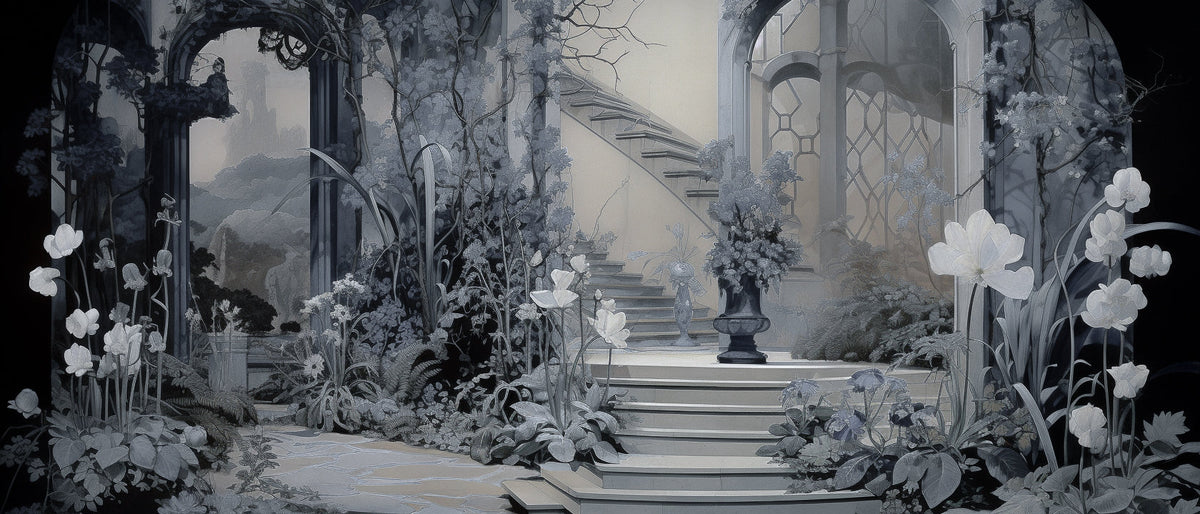
The Architectural Theory of Perfume: Building Niche Fragrance as Spatial Experience
|
|
Time to read 9 min


|
|
Time to read 9 min
Have you ever walked into a room and been instantly transported elsewhere by a lingering scent? Perhaps it was the warm, enveloping embrace of sandalwood that suddenly placed you in a centuries-old temple, or a whisper of jasmine that rebuilt your grandmother’s garden around you. This isn’t just nostalgia at work—it’s the architectural power of fragrance, a phenomenon that has become central to the world of niche fragrance and natural perfume creation.
The relationship between architecture and perfumery runs deeper than metaphor. Both disciplines craft experiences that unfold over time, create emotional responses, and transform our perception of space. While architects work with concrete, glass, and light, perfumers build with molecules, botanical extracts, and the invisible structures of scent. This architectural approach has found its most profound expression in the realm of niche fragrance, where creators approach their work with an architect’s eye for structure, detail, and spatial experience.
The marriage of architectural thinking and perfume creation isn’t merely poetic—it’s rooted in how our brains process sensory information. Research shows that humans remember 35% of what they smell compared to just 5% of what they see. This remarkable difference explains why scent can reconstruct spaces in our minds with such vivid clarity.
Modern architectural theory has evolved beyond purely visual aesthetics to embrace multisensory design—an approach that recognizes how our experience of space engages all senses simultaneously. This shift parallels the evolution in perfumery, particularly in the natural perfume movement, which emphasizes the complete sensory journey rather than just the immediate olfactory impact.
The nose is to scent what the eye is to space. This perspective has revolutionized how we understand both buildings and bottles—not as static objects but as vessels for dynamic experiences that unfold over time.
The world of niche fragrance has embraced architectural principles to create more distinctive and memorable scent experiences. Unlike mass-market products that aim for immediate appeal, niche fragrance creators approach their work with an architect’s patience, understanding that true appreciation requires exploration and discovery.
Niche fragrance emerged as a reaction against mass-market perfumery, much as modernist architecture arose in opposition to ornate historical styles. Both movements share a commitment to authenticity, innovation, and creating experiences that challenge conventional expectations.
The limited production methods in niche fragrance allow for more experimental structural approaches. Free from the commercial pressures that drive mainstream perfumery, niche creators can explore unconventional structures and materials, pushing the boundaries of what fragrance can be and how it can transform our experience of space.
This architectural approach manifests in several key movements within niche perfumery:
The meticulous craftsmanship behind artisan perfume mirrors the detailed work of architectural design. Both fields require years of technical training combined with artistic vision—a marriage of science and creativity that produces works of both functional and aesthetic significance.
Artisan perfumers, like master architects, often develop signature styles that make their work instantly recognizable. Just as you might identify a Frank Gehry building by its undulating titanium surfaces or a Zaha Hadid structure by its fluid forms, connoisseurs can often identify the creator of an artisan perfume by its distinctive structural approach.
The parallel between architectural structure and perfume composition is perhaps most evident in the traditional three-part fragrance pyramid. This fundamental organizing principle divides a perfume into top notes (the facade), heart notes (the main structure), and base notes (the foundation).
Fragrance Layer |
Architectural Parallel |
Function |
|---|---|---|
Top Notes |
Facade |
Creates initial impression |
Heart Notes |
Main Structure |
Defines character |
Base Notes |
Foundation |
Provides lasting stability |
This structural approach gives perfumes their temporal dimension—they are designed to evolve over hours, revealing different facets as they interact with the skin. The complexity of natural perfume comes from its carefully constructed layers, similar to how architects build spaces that reveal themselves gradually as you move through them.
However, contemporary niche fragrance has begun to challenge this traditional structure, just as modern architecture has moved beyond classical forms. Some innovative perfumers have created “linear” compositions that maintain a consistent character from first spray to dry-down, while others have developed “circular” structures that cycle through different notes in a continuous loop rather than a linear progression.
Organic perfume relies on materials that create both structural integrity and beauty in the final composition. Like organic architecture, which emphasizes harmony between human habitation and the natural world, organic perfumery seeks to create fragrances that work in harmony with the body and environment.
The principles of biophilic design—which incorporates natural elements into built environments—find their olfactory equivalent in organic perfume creation. Both approaches recognize that our connection to natural materials runs deep and that synthetic substitutes, however technically perfect, often lack the complex resonance of natural elements.
Natural perfume creators often draw inspiration from organic architecture, using materials that work in harmony with the wearer. This approach requires deep knowledge of how natural materials interact, evolve, and complement each other—a skill set comparable to that of architects who work with living systems and sustainable materials.
Creating effective scentscapes requires understanding several technical factors:
Air Flow Dynamics: How scent molecules move through space
Diffusion Patterns: How different materials project and create “scent bubbles”
Material Interactions: How ingredients influence each other’s performance
These technical considerations parallel the architect’s concern with air circulation, light diffusion, and material compatibility. Both disciplines require balancing aesthetic vision with technical reality to create successful experiences.
The spatial dimension of fragrance becomes particularly evident in the concept of “sillage”—the trail a perfume leaves in the air as you move through space. Different materials create different types of sillage: some project boldly, creating a large olfactory footprint, while others stay closer to the skin, creating a more intimate experience.
Understanding structural elements is essential when learning how to choose natural perfume that resonates with you. A fragrance that projects boldly might create an unwanted spatial presence in close quarters, while one with minimal sillage might disappear in larger spaces.
The growing interest in natural perfume parallels the rise of sustainable architecture—both movements represent a return to traditional materials and methods, adapted for contemporary sensibilities and environmental concerns.
Natural perfume creators, like sustainable architects, face the challenge of working with renewable resources without compromising on performance or aesthetic appeal. This constraint often drives innovation, leading to new techniques for extracting, preserving, and combining natural materials.
The principles of sustainable architecture—minimizing environmental impact, using renewable resources, and creating healthy environments—find their olfactory equivalent in natural perfumery. Both fields have moved from the margins to the mainstream as consumers increasingly prioritize health and environmental considerations.
When considering how to choose natural perfume, think about the spatial experience you want to create. Do you want a scent that creates an intimate space that only those closest to you will experience? Or are you looking for something that announces your presence more boldly? These spatial considerations are central to the architectural approach to fragrance.
The future of sustainable fragrance lies in applying architectural principles that maximize impact while minimizing resource use. Just as sustainable architecture works with natural elements, sustainable fragrance harnesses the power of natural materials to create experiences that are both beautiful and responsible.
Emerging technologies are enabling new approaches to sustainable fragrance creation:
CO2 Extraction: Allows for more efficient use of precious botanical materials
Upcycled Ingredients: Transforms waste products into valuable fragrance materials
Biotechnology: Creates sustainable alternatives to endangered or unethical materials
These innovations parallel developments in sustainable architecture, where new technologies are making it possible to create more environmentally responsible buildings without sacrificing beauty or functionality.
Just as smart buildings respond to environmental conditions and user needs, new technologies are enabling responsive fragrance experiences:
Programmable Diffusion: Systems that adjust scent release based on time of day or activity
Environmental Response: Fragrances that adapt to humidity, temperature, or air quality
Personalized Experiences: Scent systems that learn individual preferences
These technologies are transforming how we think about fragrance as a spatial element, moving from static compositions to dynamic systems that respond to changing conditions.
The application of scent architecture to health and wellbeing represents one of the most promising frontiers in this field:
Stress Reduction: Carefully designed scentscapes that promote relaxation
Cognitive Enhancement: Fragrance structures that improve focus and mental clarity
Spatial Navigation: Scent markers that help orient people in complex environments
These applications draw on research showing that our olfactory system has profound effects on our psychological and physiological state—a connection that both architects and perfumers are beginning to explore more systematically.
Applying architectural theory in perfumery has revolutionized how we understand fragrance development. The intersection of architectural theory in perfumery has created a new language for discussing scent, one that recognizes its spatial and temporal dimensions.
The architectural approach to perfumery represents more than just a useful metaphor—it’s a fundamental shift in how we understand the creation and experience of fragrance. By recognizing the spatial dimension of scent, perfumers can create more sophisticated, nuanced compositions that engage us on multiple sensory levels.
For consumers, understanding the architectural principles behind perfume creation offers a richer appreciation of these complex creations. Rather than simply asking “Do I like this smell?”, we can begin to explore how a fragrance creates space, evolves over time, and interacts with our bodies and environments.
As both architecture and perfumery continue to evolve, the dialogue between these disciplines promises to yield new insights and innovations. The future of niche fragrance and natural perfume lies not just in new materials or techniques, but in this deeper understanding of how scent shapes our experience of the world around us.
The next time you apply a perfume, take a moment to consider its architecture—the spaces it creates, the journey it offers, and the invisible structure that supports its evolution from first impression to final memory. In that moment of awareness, you’ll experience fragrance not just as a pleasant smell, but as a form of olfactory architecture that transforms your personal space in subtle yet profound ways.
Pallasmaa, J. (2012). The Eyes of the Skin: Architecture and the Senses. John Wiley & Sons.
Henshaw, V. (2013). Urban Smellscapes: Understanding and Designing City Smell Environments. Routledge.
Turin, L., & Sanchez, T. (2010). Perfumes: The A-Z Guide. Penguin Books.
Aftel, M. (2014). Fragrant: The Secret Life of Scent. Riverhead Books.
Diaconu, M. (2011). “Senses and the City: An Interdisciplinary Approach to Urban Sensescapes.” LIT Verlag.
Herz, R. S. (2016). “The Role of Odor-Evoked Memory in Psychological and Physiological Health.” Brain Sciences, 6(3), 22.
Spence, C. (2020). “Using Ambient Scent to Enhance Well-Being in the Multisensory Built Environment.” Frontiers in Psychology, 11, 598859.
Ellena, J. C. (2012). Perfume: The Alchemy of Scent. Arcade Publishing.
Drobnick, J. (2006). The Smell Culture Reader. Berg Publishers.
Barwich, A. S. (2020). Smellosophy: What the Nose Tells the Mind. Harvard University Press.